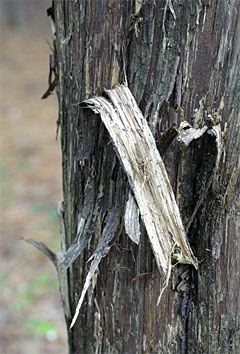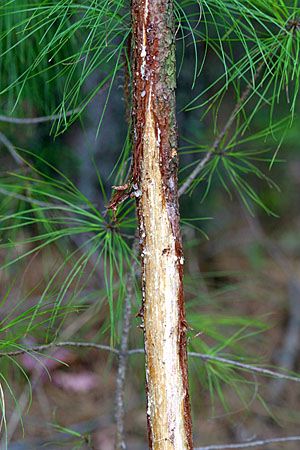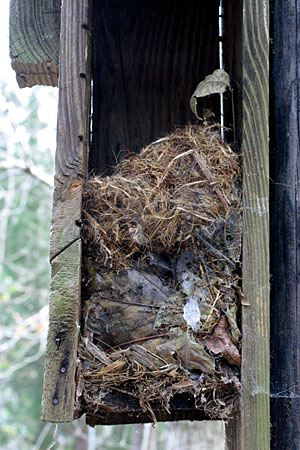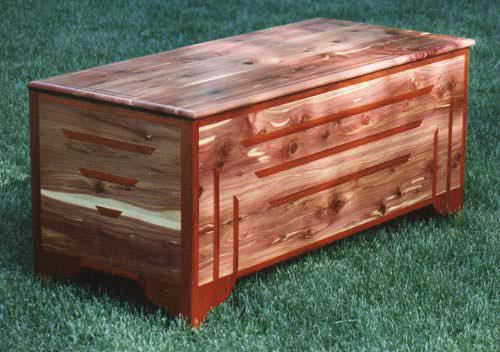All text & photos © Hilton Pond Center
In 1982 when we first moved to Hilton Pond Center, the site had been in row crops and graze for perhaps a century. Over the past 23 years, we've let nature take its course and vegetational succession has converted the 11 acres from grassy old field to mixed woodland. About ten years ago, portions of the property were so densely covered by 12-foot Eastern Red Cedars it was impossible to see more than a yard or two through their dense, green branches. Mingled among the cedars were sapling Winged Elms and Sweetgums--fast-growing hardwoods that eventually shot to the canopy and cast shade. Eastern Red Cedars don't care for shady situations--they do best in open areas where they acquire conical Christmas tree shapes--so they still tried to reach for the sun. As the slower-growing cedars began losing the battle of succession, their light-starved bottom branches dropped all needles--making the woods more open at eye-level.  Now that the shortest trees have been shaded out completely, the understory of our Hilton Pond woods includes an army of dead-standing Eastern Red Cedars (top photo).
Now that the shortest trees have been shaded out completely, the understory of our Hilton Pond woods includes an army of dead-standing Eastern Red Cedars (top photo).
Although healthy Eastern Red Cedars have dark, reddish-brown bark (right), good numbers of the lifeless nevergreens have no bark at all, and the bright tan of their underlying wood stands out starkly amongst the winter drab. These particular trees have been stripped of every vestige of their stringy bark, raising the question of what did the stripping. We enjoy using the Socratic Method to help our visitors solve this "Mystery of the De-barked Cedars," but sometimes it takes a while for the whole story to unfold.
When we ask visiting groups how the dead cedars might have lost their bark, the usual answers are "birds" or "the wind" or "some kind of insect." Although some stringy bark might have been removed by nest-building birds, the prevalence of naked cedars in the woods rules out avifauna as the main perpetrators, and insects and wind couldn't have done it all either.  We ask our visitors to think a little longer and, if they need a hint, we suggest the bark-strippers were mammals. This typically results in a quizzical response of "Deer rub?", but the bare area on the trunk goes much higher than White-tailed Deer bucks can reach while rubbing velvet from their antlers--as they often do on low-growing pine saplings around Hilton Pond (left).
We ask our visitors to think a little longer and, if they need a hint, we suggest the bark-strippers were mammals. This typically results in a quizzical response of "Deer rub?", but the bare area on the trunk goes much higher than White-tailed Deer bucks can reach while rubbing velvet from their antlers--as they often do on low-growing pine saplings around Hilton Pond (left).
Eventually someone says "Squirrels must have done it," after which we ask "What kind?" In turn, the visitor usually specifies "gray squirrel." Indeed, we have observed Eastern Gray Squirrels gathering cedar bark, but our visitors to Hilton Pond haven't, and since it's impossible to get a group into the top of a towering oak we can't show them contents of a tree squirrels' nest. Thus, we ask if another squirrel might have gathered the bark. At some point the group's eyes light up as one of them happily sings out "flying squirrel!" Now THAT'S a squirrel we can deal with because Southern Flying Squirrels, Glaucomys volans, don't nest in the highest treetops and often occupy human-made bluebird boxes down low where we can see them.
Since Hilton Pond Center happens to have a bunch of nestboxes--no longer occupied by bluebirds now that the woods have matured--we lead the group to a nearby pole where an old box still hangs.  Sure enough, when we open the side of the nestbox, we see a big wad of plant material consisting of--you guessed it!--a few leaves but mainly the shredded bark of Eastern Red Cedar (right).
Sure enough, when we open the side of the nestbox, we see a big wad of plant material consisting of--you guessed it!--a few leaves but mainly the shredded bark of Eastern Red Cedar (right).
If the box is active, the visitors are soon treated to the rare sight of a flying squirrel popping out of the box, running up the pole, and then gliding off to a nearby tree--a behavior more likely to occur at night than in broad daylight. When everyone is finished oohing and aahing over the squirrel's aerobatic antics, we return to the Socratic discussion at hand, which now leads to "So why do you think a flying squirrel might gather red cedar bark and stuff it in its nestbox?"
The groups's logical conclusion is that cedar bark provides insulation and helps keep a flying squirrel warm, but in our judgment this isn't the main function--especially since the woods provide plenty of other soft, fluffy plant material the squirrel might choose from. That's when we pose yet another question that requires our visitors to think a little about human history: "When the first settlers came over from Europe, what were their most valued possessions?"
This time the answers range from "guns" to "tools" to "livestock" to "vegetable seeds they could plant" in the New World. We agree all these were important but that none would matter if settlers didn't make it through their long, cold first winter. This idea leads our visitors to conclude that cold-weather clothing would also be a very important commodity and that woolen garments might save the day if temperatures dropped really low. And that, as Paul Harvey says, is "the rest of the story."
As they sailed over from Europe, early settlers most certainly would have brought their woolen undies--potentially life-saving clothing they were careful to protect from the ravages of wool-eating caterpillars.  To deter moth larvae, Europeans for generations have stored their woolens in boxes made from Old World cedars, primarily because cedar wood contains highly aromatic oils that repel insect pests. As you know from sniffing any U.S.-made cedar chest, our native Eastern Red Cedar is at least as pungent, so we contend the Southern Flying Squirrels that collect cedar bark are lining their homes with natural bug repellent. Use red cedar to decorate your nest and your fleas, flies, and mites go elsewhere.
To deter moth larvae, Europeans for generations have stored their woolens in boxes made from Old World cedars, primarily because cedar wood contains highly aromatic oils that repel insect pests. As you know from sniffing any U.S.-made cedar chest, our native Eastern Red Cedar is at least as pungent, so we contend the Southern Flying Squirrels that collect cedar bark are lining their homes with natural bug repellent. Use red cedar to decorate your nest and your fleas, flies, and mites go elsewhere.
We doubt our flying squirrels at Hilton Pond Center comprehend the bug-busting value of red cedar bark in their nests. Those that gather it, however, likely have fewer nest parasites and pass on their cedar-seeking genes through higher numbers of surviving offspring. Early settlers in North America likewise survived in part by having warm clothes, but all they did by storing woolens in cedar boxes was imitate what flying squirrels did first. To be fair and honest, the original patent and all future royalties for the "bug-free" cedar chest should go to Mother Nature, the real "mother of invention."
 You can also
You can also